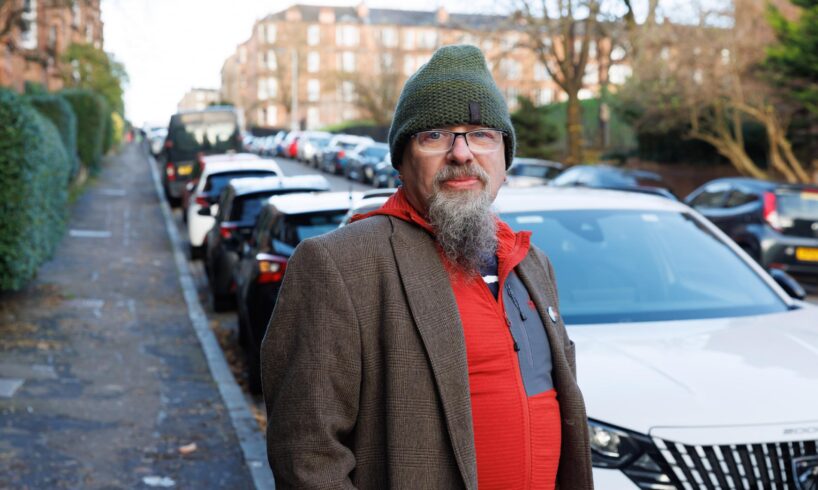
Streets across Thornwood and Broomhill in the West End are subject to a consultation about introducing new regulations, which would see several streets start to charge for parking.
This would include Crow Road, Thornwood Avenue, Churchill Drive and more.
Many locals welcome the change as they say the area is saturated with cars, making it inaccessible.
They see the charges as a way to reduce the amount of vehicles on the road.
Shaun Conroy (Image: Colin Mearns)
Proposed Parking Controls in the Broomhill and Thornwood area of Glasgow (Image: Colin Mearns)
Shaun Conroy, from Thornwood Community Council, said: “A lot of people are not able to move freely within our community.
“There is a difficulty with prams, wheelchairs and mobility scooters.
“They have to put themselves at risk by having to detour on the road.
“Recently, one of our neighbours fell over. He couldn’t get across the road because all the drop curbs were parked upon.”
However, other residents are up in arms about the proposal, claiming that the extra parking charge will weigh heavy on people’s finances.
Mr Conroy continued: “There is a solution in it. The question is the cost to vulnerable families.
“There is already a cost-of-living crisis and people are really struggling with the price of food and services.
“To add an additional £100 a year to that feels a little unfair.
“People have a right to be concerned about the cost.”
READ NEXT: We are at wits end with tragic parking in this Glasgow area
Proposed Parking Controls in the Broomhill and Thornwood area of Glasgow (Image: Colin Mearns)
Proposed Parking Controls in the Broomhill and Thornwood area of Glasgow. Pictured are cars parked on Broomhill Drive (Image: Colin Mearns)
Mark Deluca, 32, who has lived in Thornwood for seven years, said safety should be a priority.
He said: “I have bever seen my street empty. Every day from 7am until the end of the day, it’s full.
“People drive in to get the train from the train station or to go to the Queen Elizabeth University Hospital.
“It makes sense to charge people. Without dedicated car parks, people will continue to double-park up residential streets.
“My street is incredibly dangerous. People fly down the hill.”
An elderly resident said she understood why these measures are needed.
She told the Glasgow Times: “It will stop people parking here and then going away to the town.
“You’re not going to get people as much.”
Shaun Conroy (Image: Colin Mearns)
READ NEXT: Glasgow business to relocate after 13 years as parking charges ‘quadrupl
But Thomas Marsden, who has lived here since 1988, said he “totally disagrees” with the proposal.
He said: “It’s another desperate attempt by the council to bring in more revenue.
“Spaces are limited but I don’t think the council has a right to take more money off the residents.
“I totally disagree with it.”
Martin Watt, 61, explained that it’s a “nightmare” to park in the area and the plan won’t fix this.
He added: “I can understand doing it in other areas and I wouldn’t mind paying £80 if I was guaranteed a space.
“But it doesn’t make sense here.”
A local businessman remarked: “It will definitely affect people coming to the area, which will then affect my business.
“A lot of my customers drive in, it’s a destination to come here.
“It will make people think twice about coming here.
“It’s a hard time for small businesses. Every penny is a prisoner, so losing out on another £1000 is not ideal.
“I have never had issues with parking, I’m able to get a space every day.”
Proposed Parking Controls in the Broomhill and Thornwood area of Glasgow (Image: Colin Mearns)
Proposed Parking Controls in the Broomhill and Thornwood area of Glasgow (Image: Colin Mearns)
According to the plan, annual permits would cost between £80 and £220 annually, depending on engine size, while businesses would have to fork out £1050.
Visitor would be charged £1.20 per 15 minutes and would be allowed to stay for three hours.
More information on the proposal is available here and locals can voice their opinions online until January 4, 2026.
The council said the changes would benefit all road users by reducing congestion, improving traffic flows and managing limited road space.
It would also improve safety for pedestrians and cyclists.





